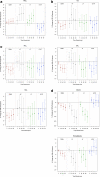Traffic-related air pollution exposures and changes in heart rate variability in Mexico City: a panel study
- PMID: 23327098
- PMCID: PMC3639920
- DOI: 10.1186/1476-069X-12-7
Traffic-related air pollution exposures and changes in heart rate variability in Mexico City: a panel study
Abstract
Background: While air pollution exposures have been linked to cardiovascular outcomes, the contribution from acute gas and particle traffic-related pollutants remains unclear. Using a panel study design with repeated measures, we examined associations between personal exposures to traffic-related air pollutants in Mexico City and changes in heart rate variability (HRV) in a population of researchers aged 22 to 56 years.
Methods: Participants were monitored for approximately 9.5 hours for eight days while operating a mobile laboratory van designed to characterize traffic pollutants while driving in traffic and "chasing" diesel buses. We examined the association between HRV parameters (standard deviation of normal-to-normal intervals (SDNN), power in high frequency (HF) and low frequency (LF), and the LF/HF ratio) and the 5-minute maximum (or average in the case of PM(2.5)) and 30-, 60-, and 90-minute moving averages of air pollutants (PM(2.5), O(3), CO, CO(2), NO(2), NO(x), and formaldehyde) using single- and two-pollutant linear mixed-effects models.
Results: Short-term exposure to traffic-related emissions was associated with statistically significant acute changes in HRV. Gaseous pollutants - particularly ozone - were associated with reductions in time and frequency domain components (α = 0.05), while significant positive associations were observed between PM(2.5) and SDNN, HF, and LF. For ozone and formaldehyde, negative associations typically increased in magnitude and significance with increasing averaging periods. The associations for CO, CO(2), NO(2), and NO(x) were similar with statistically significant associations observed for SDNN, but not HF or LF. In contrast, PM(2.5) increased these HRV parameters.
Conclusions: Results revealed an association between traffic-related PM exposures and acute changes in HRV in a middle-aged population when PM exposures were relatively low (14 μg/m(3)) and demonstrate heterogeneity in the effects of different pollutants, with declines in HRV - especially HF - with ozone and formaldehyde exposures, and increases in HRV with PM(2.5) exposure. Given that exposure to traffic-related emissions is associated with increased risk of cardiovascular morbidity and mortality, understanding the mechanisms by which traffic-related emissions can cause cardiovascular disease has significant public health relevance.
Figures

References
-
- Lipsett MJ, Ostro BD, Reynolds P, Goldberg D, Hertz A, Jerrett M, Smith DF, Garcia C, Chang ET, Bernstein L. Long-term Exposure to Air Pollution and Cardiorespiratory Disease in the California Teachers Study Cohort. Am J Respir Crit Care Med. 2011;184:828–835. doi: 10.1164/rccm.201012-2082OC. - DOI - PMC - PubMed
-
- Pope CA Jr, Burnett RT, Thurston GD, Thun MJ, Calle EE, Krewski D, Godleski JJ. Cardiovascular mortality and long-term exposure to particulate air pollution: epidemiological evidence of general pathophysiological pathways of disease. Circulation. 2004;109:71–77. - PubMed
-
- Chuang KJ, Coull BA, Zanobetti A, Suh H, Schwartz J, Stone PH, Litonjua A, Speizer FE, Gold DR. Particulate air pollution as a risk factor for ST-segment depression in patients with coronary artery disease. Circulation. 2008;118:1314–1320. doi: 10.1161/CIRCULATIONAHA.108.765669. - DOI - PMC - PubMed
Publication types
MeSH terms
Substances
Grants and funding
LinkOut - more resources
Full Text Sources
Other Literature Sources
Research Materials
Miscellaneous

